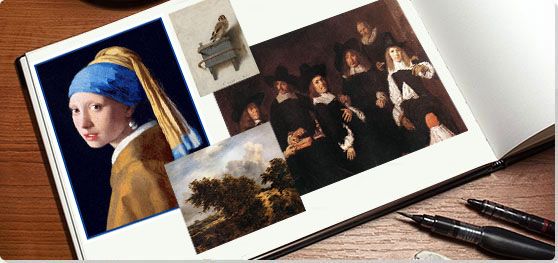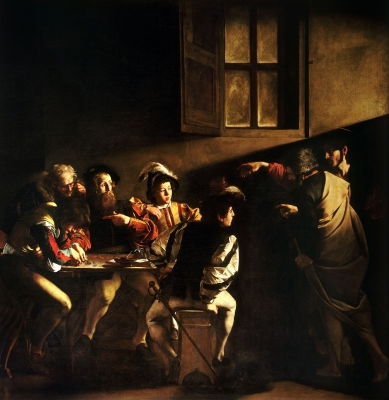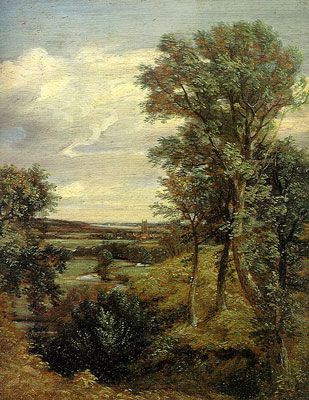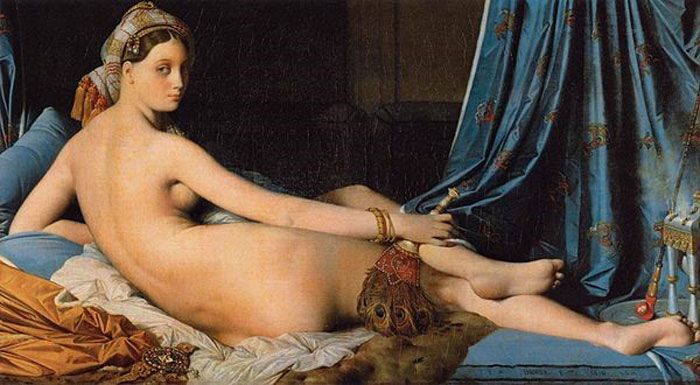Summary of Dutch Golden Age Painting
The Dutch Golden Age is one of the finest examples of independence breeding cultural pride. During the 17th century, driven by new freedom from Spanish Catholic rule, the Dutch Republic experienced a surge in economic and cultural prominence. An influx of trade boosted commerce, leading to the rise of a large middle and merchant class in the market for the proliferation of art that had cropped up in response to the burgeoning celebration of Dutch life and identity. Painting flowered as artists focused on everyday scenes of ordinary life, expressed through a growing cadre of genre works, all indicative of the thriving creative period.
Key Ideas & Accomplishments
- The Dutch Reformed church and a rising sense of Dutch nationalism informed the Golden Age. Art too took on independent directions, developing an emphasis on secular subjects, depicted not with Catholic grandeur, but emphasizing ordinary human life and realistic treatments. As a result, some scholars have referred to Dutch Golden Age painting as Dutch Realism.
- Landscape painting exploded during the Dutch Golden Age, bringing with it an emphasis upon the unique characteristics of Dutch landscape features, villages, and rural life connected with a rising esteem for Dutch values. Many of these scenes were based on central "heroic" elements indigenous to the area such as a tree, windmill, or cloud-filled sky.
- Genre painting experienced a magnificent evolution, with multiple creative sub-genres birthing a distinct look at the contemporary lifestyle, trends, and interests of the Dutch people of the time. Subjects ranging from lavish breakfast tables to group portraits to moments of merriment and little trifles helped establish an artistic document of the period.
- The stilleven, or still life surged in popularity, utilized to imaginatively express both objects of beauty and the philosophical climate of the times through carefully composed arrangements and groupings. This dominant element of Dutch art developed into a number of subtypes of which floral still life, presented with scientific accuracy, was the most popular.
Artworks and Artists of Dutch Golden Age Painting
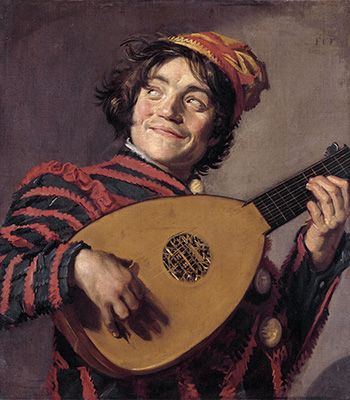
The Lute Player
This genre piece depicts a lute player, his body turned toward the viewer, while he saucily looks to his left. The lute's intricately carved sound hole centers the lower half of the canvas, while the diagonal created by its neck extending out of the cropped frame conveys a sense of movement. The player seems to be in mid-movement, his right hand strumming the strings, his left fingering a chord on the neck, as he cocks his head sideways, smiling. The red and black pattern of his jester's costume, marked by prominent yellow buttons, adds to the festive and entertaining air, while the clear light lends to the sense of immediacy.
Frans Hals' painting technique, dubbed the "rough style," was innovative, as he used quick loose brushwork to create energetic movement. His work transformed the genre that was introduced by Dirck van Buburen, as his figures moved realistically, caught in the midst of action. As art critic Roberta Smith wrote, "Mostly through cropping and enlargement, these works elevate genre painting into a form of clear-eyed portraiture...and in their sense of motion they sometimes presage the modern snapshot."
Other Dutch painters of the era, including David Bailly and Jan Steen, as well as the 19th century Adrian de Lelie, copied this work or incorporated aspects of it. Hals' rough style had a noted influence on later artists of the Realist movement, including Courbet and Manet, and of the Impressionist movement, including Monet and Mary Cassatt. Robert Henri, part of the American group, the Eight, went to Haarlem to study Hals' work whose influence is apparent in Henri's Dutch Girl in White (1907).
Oil on canvas - Musée du Louvre, Paris
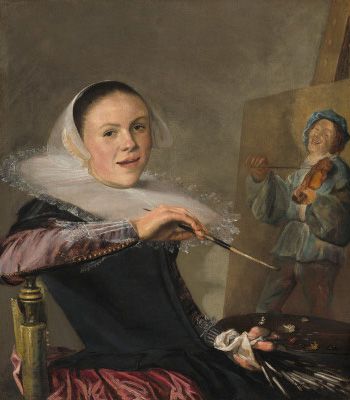
Self-Portrait
This self-portrait shows the artist at her easel, turning in mid-stroke, with brush in hand to face the viewer. The diagonal of her torso as she turns, the play of light suggesting movement in her lace collar and her sleeve, and her facial expression, lips open as if beginning to smile, create a sense of lively immediacy. On the easel to the right, an animated musician dressed in blue, is playing a violin and singing along. The painting within a painting further emphasizes Leyster's self-presentation as a masterful painter of genre works. Here she innovatively compares the arts of music and painting in the echoing diagonals of the musician's bow and the painter's brush, while her use of cropping makes the painting seem almost as spontaneous as a snapshot.
Leyster's treatment here is a noted innovation of self-portraiture as, in effect, she is marketing her brand, as the musician depicted here is copied from her most popular work The Happy Couple (1630). At the same time, X-rays have shown that painting on the easel was originally a girl's portrait, probably a self-portrait, and as art critic Peter Schjeldahl wrote, "the literal self-effacement tells a melancholy tale, but the painting is a joy and, retroactively, a feminist icon." The artist's brush points at the musician's crotch, a bawdy allusion common to the time. Beneath Leyster's vibrant surfaces, Schjeldahl notes, "social and sexual anxieties tingle with fire-alarm immediacy."
In the years following her death, Leyster's work disappeared, as her works were attributed to Frans Hals, or to her husband, the painter Jan Miense Molenaer. In 1893 the Louvre purchased The Happy Couple (1630), believing it to be a work of Hals, only to discover Leyster's signature and trademark, a star symbol playing upon the meaning of her last name "lodestar." Though the work had been much praised by critics when attributed to Hals, subsequently they demoted the work for its "weakness." Feminist art scholars, such as Linda Nochlin, and artists like the Guerrilla Girls, beginning in the 1970s, launched a revival of interest in Leyster's work.
Oil on canvas - The National Gallery of Art, Washington DC
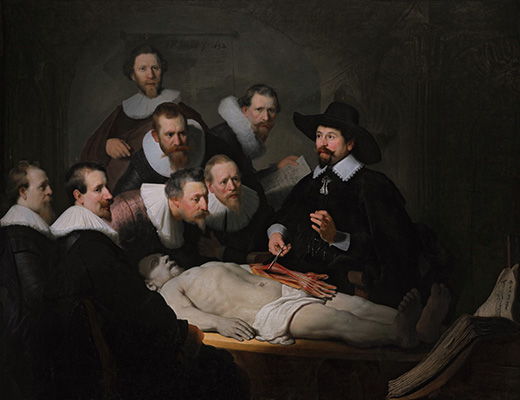
The Anatomy Lesson of Dr. Nicolaes Tulp
This iconic painting shows Dr. Tulp providing an anatomy lesson, as the forceps in his right hand lift a tendon from the partially dissected arm of a man who had been executed for armed robbery earlier that morning. Tulp looks toward the seven men gathered around the corpse as his left hand gestures to explain an anatomical point. The men, their white collars and fine clothes indicating their wealth, look in various directions. The three closest to the center lean forward as if watching Tulp's hands, while the two in the back look out toward the viewer. The two on the far left, depicted in profile, face toward Tulp but seem to be looking beyond him, outside the picture frame. A sense of dynamic movement and psychological complexity results, as no one returns Tulp's gaze or looks directly at the pale corpse. The umbra mortis, or shadow of death, fills the center of the canvas. The man's body, his genitals covered with a piece of white linen, evokes the iconography of Christ's death, though here, the body is forgotten, at the same time his dissected arm grimly conveys death's reality.
In this work, Rembrandt innovatively transformed group portraiture by dramatically focusing on the event in mid-action, rather than merely presenting a posed scene. As a result the work becomes a mise-en-scene, a kind of graphic documentary, and a masterful portrait.
The Amsterdam Guild of Surgeons commissioned the group portrait, Rembrandt's first important one in the city. The men attended the Guild's annual public dissection in 1632 at which Dr. Tulp, the City Anatomist, presided. In 17th century Holland, anatomical lessons were noted social events, accompanied by music, conversation, and food and wine, taking place in theater lecture rooms, and attended by those who could afford the entrance fee. The well-dressed appearance of these men, their white collars and fine gowns, testify to their social importance, and yet, they are presented as if both sensationalized and distracted, their humanity overshadowing their status.
Manet painted a copy of this painting in 1856 after studying it on a trip to the Netherlands, and the American realist Thomas Eakins was also influenced by it in painting his The Gross Clinic (1875). The executed man Kindt has also taken on a kind of later cultural life, referred to in W. G. Sebald's The Rings of Saturn (1999) and in Nina Siegal's The Anatomy Lesson (2014), which tells his story.
Oil on panel - Mauritshuis, The Hague, Netherlands
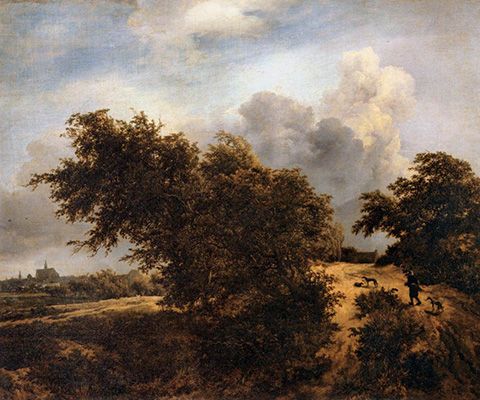
Dune Landscape near Haarlem
This landscape, showing a hunter and his dogs climbing a dune on the right, primarily focuses on the great tree in the center of the frame. Its thick volume sways to the left, drawing our attention to the skyline of Haarlem in the distance. To the right of the tree, the sunlit road curves toward the horizon and draws our gaze upward to the cumulus clouds whose billowing and energetic shapes echo the two trees' dense foliage. A feeling of great energy results as, simultaneously, the figurative element of the hunter and his dogs conveys a feeling of ordinary life in harmony with nature as they trek toward the farmhouse glimpsed at the end of the curving road.
With its strong sense of composition, this work exemplified Ruisdael's classical phase. His innovative technique involved applying paint thickly in order to build up layers of light and shadow to create a sense of depth and profusion of vegetation. At the same time, he employed scientific observation, depicting botanically identifiable trees, leading art historian Kenneth Clark to describe him as "the greatest master of the natural vision before Constable."
Prolific, van Ruisdael worked in almost all of the genres of Dutch Golden Age landscape painting. He helped pioneer distinct motifs such as the depiction of water mills. He was influential upon artists of his own time and his work had a noted impact on the Barbizon School and the Hudson River School. Artists Thomas Gainsborough, J.M.W. Turner, and John Constable all studied and copied his landscapes. He also impacted the Impressionists including Monet and the Post-Impressionist Vincent van Gogh.
Oil on canvas - Musée du Louvre, Paris
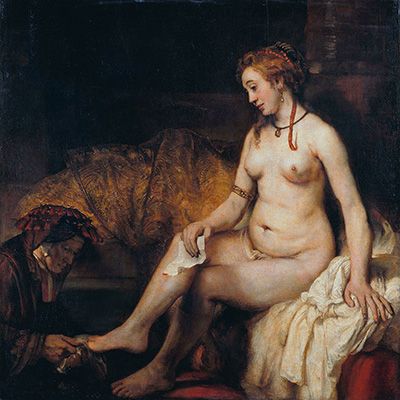
Bathsheba at Her Bath
Also called Bathsheba with King David's Letter, this painting depicts Bathsheba nude at her bath while she pensively ponders the King's letter in her right hand. The rich colors, the copper and gold draperies in the background, echoed by the gleaming gold of Bathsheba's jewelry emphasize the luminous glow of her nude body. The use of chiaroscuro seen in the white linen contrasting with the dark background and the highlights of her skin contrasting with the fabric's softly shadowed folds creates a sensual presence. The body here is almost palpable, drawing the viewer's eye. The painting is based upon the Biblical account of how King David, having seen Bathsheba bathing, commanded her to come to his palace, even though she was married to one of his generals, Uriah. When she obeyed and became pregnant as a result, David had her husband sent into the front lines of battle to be killed so that he could marry her. Subsequently, their child was stillborn, and David, realizing his sinfulness, did penance sitting in rags and ashes at the city's gate for a year. For the religious viewers of the time, the familiar Biblical story would have added a sense of fateful foreshadowing to the moment depicted here, as if Bathsheba were pondering not only her moral and personal dilemma, but also what would follow. The maidservant, kneeling at left to wash her foot, has her gaze discreetly lowered in darkness, as if aware of what the letter means.
Going against the current of his time, Rembrandt was the only great artist of the nude in the Dutch Golden Age, though he transfigured the genre by, as Simon Schama noted, creating "the first depiction of a woman thinking." The model for this painting is thought to be Hendrickje Stoffels, Rembrandt's life companion, though that attribution continues to be debated. Nonetheless, the work conveys intimacy of presence and of thought.
This work influenced Manet's The Surprised Nymph (1859-1861), Degas' Women Having Her Hair Combed (c. 1885), Frédéric Bazille's La Toilette (1870), and Picasso's Seated Nude and Another Figure (1963). Picasso was particularly influenced by Rembrandt, whom he took for a kind of alter ego, saying "every painter takes himself for Rembrandt."
Oil on canvas - Musée du Louvre, Paris
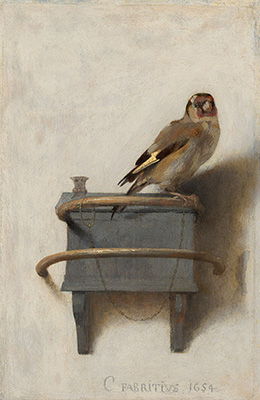
The Goldfinch
This small painting depicts a European goldfinch, painted to scale at about four inches long, perched on its feedbox, to which it is attached by a fine gold chain looped on the brass ring that holds the box in place. The bird, shown in profile, turns toward the viewer with an alert, evocative expression.
Known for his innovative painting of the effects of light, here Fabritius used light and shadow conveyed in subtle tones to create a three-dimensional effect. He also used trompe d-oeil to make the painting appear real as it was hung in the kitchen, slightly above eye level, where the Dutch often kept goldfinches as pets. As Marco della Cava wrote of the work it is "a stark and faintly modernist rendition," with its fresh and simple immediacy, but the Calvinist audience of the era would have also have seen the goldfinch as a symbol of the resurrection, as its red spots and its feeding upon thistles were associated with Christ's passion.
Fabritius was only thirty-two when he was killed and most of his works were destroyed in a 1654 gunpowder explosion in Delft that destroyed a fourth of the city. Nevertheless, he was among the most admired of Rembrandt's students and would go on to influence Vermeer.
This enigmatic painting is at the center of Donna Tartt's novel The Goldfinch (2013), which is being made into a feature film of the same title.
Oil on panel - Mauritshuis, The Hague, Netherlands
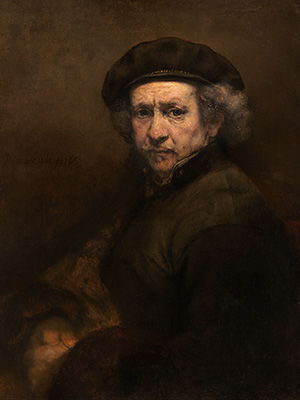
Self-Portrait
This self-portrait depicts the artist, wearing a beret and a fine coat with upturned collar, his body in three quarter profile view, as he faces the viewer with a complex gaze. His slightly furrowed brow and deep-set eyes convey resolute strength and intensity, while the light, illuminating his face in rich variations of flesh tones with touches of pink, evokes vitality. The painting is strongly composed, his form a pyramid emphasized by the glow upon his left shoulder and his lit up clasped hands, rendered somewhat impressionistically. The brown background, though dark, is atmospherically rich and varied and counterpoints the darker tones of his coat. He seems to be surrounded by a kind of gravity that both emphasizes his illuminated face and adds an air of dignity.
Rembrandt had come to near financial ruin in 1659, as the previous year his house and possessions had been auctioned to pay his creditors, and the brooding quality of this work while reflecting, perhaps, the profound self-assessment that followed, is simultaneously a statement of artistic mastery. In 1639 Rembrandt encountered Raphael's Balthasar Castiglione (1514-1515), a noted portrait of the Humanist scholar, known as an ideal representative of High Renaissance "nonchalant mastery." Subsequently, Rembrandt made several sketches of the work, as well as an etching Self-portrait Leaning on a Stone Sill (1639), portraying himself in a similar pose, wearing a similar, but more contemporary, beret and dark clothing. This work becomes, in effect, Rembrandt's reply to the High Renaissance.
Rembrandt was the Dutch Golden Age's greatest portraitist, and almost modern in his emphasis on self-portraits, painted continually throughout his career. He influenced van Gogh and Rodin and had a noted impact on the 20th century influencing Frank Auerbach, who praised what he called the artist's "raw truth," and Francis Bacon. As art historian Pilar Ordovas noted, "Rembrandt was crucial to Bacon in terms of mark-making and the handling of paint." In this late work, his brushwork is loose and almost Impressionistic, as art critic Mark Hudson wrote, "Yet it is also the trajectory we expect art to take: away from tightness, order and control, towards expressivity and abstraction. As Rembrandt invents himself in paint, so he invents Modern Art as he goes."
Oil on canvas - The National Gallery of Art, Washington DC
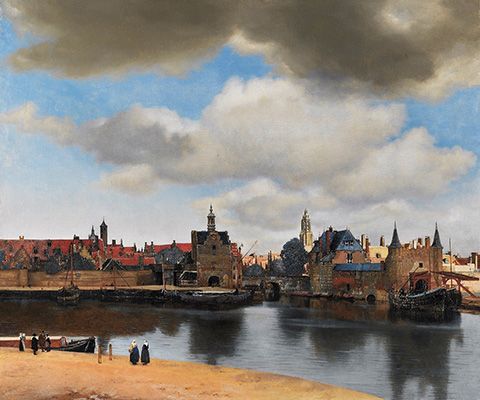
View of Delft
This accurately observed landscape shows the buildings of the artist's hometown of Delft, its roofs and steeples, caught in shadow and light, beneath the gathering clouds in a blue sky. The waters of the Schie Canal shimmer with rippling currents and the reflections of buildings. A number of precisely detailed people gather on the shore in the left, each of them representative of Delft life. Yet, the light here is what matters, as the sky takes up almost two thirds of the canvas, its contrasting tones creating glowing areas of illumination and the shadows of dawn. As art historian Adriaan Waiboer wrote, while "Vermeer was truly capturing what he saw in front of him," he primarily "wanted to create a special illusion...he wanted to paint light." Using only white, ultramarine, yellow ochre, and madder lake, a rich shade of red, the color palette is very simple yet employed with subtle tonalities to create a feeling of harmony.
Vermeer painted three landscapes of his hometown, and this cityscape is considered one of his masterpieces. As art historian Mariët Westermann wrote, "The scene's varied light effects look so natural...that the eye ignores what the mind knows: that this light is high artifice, that it is a work of painting." The painting led to the Vermeer's rediscovery when the French critic Thoré-Bürger saw it in 1842, and as a result, went on to influence subsequent artists, including Camille Pissarro, Manet, Edgar Degas, and Henri Fantin Latour. This painting is also one of the artist's most popular, as shown in its being reproduced by the Royal Dutch Mint on 2011 gold commemorative coins in 2011. The famous French novelist Marcel Proust said, "Ever since I saw the View of Delft in the museum in The Hague, I have known that I had seen the most beautiful painting in the world," causing him to include the work in his seminal novel Remembrance of Things Past (1908).
Oil on canvas - Mauritshuis, The Hague, Netherlands
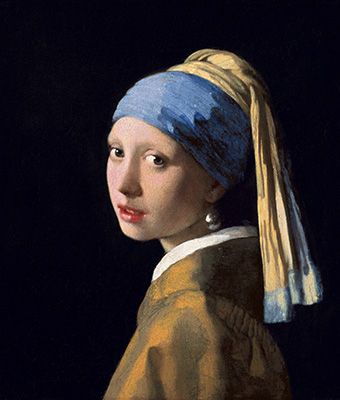
Girl with a Pearl Earring
This iconic world-renowned portrait shows a young woman in three quarter view as she turns to look at the viewer with an intimate but mysterious gaze. The color palette of her costume, limited to shades of yellow, blue, and white softly contrast with the flesh tones of her face and red lips, drawing our attention to her luminous eyes. She looks toward the viewer as if drawn by a word of address, a pearl earring gleaming against the soft shadows of her neck. Featuring the pearl so prominently, the artist subtly emphasized the Christian symbolism of pearls as emblems of chastity. At the same time, the orientalism of her turban and robe create a contrasting element of exotic eroticism. As no known pearl exists of that size, it is either a glass bead covered with nacre or imagined by the artist.
Vermeer's work was unique for his liquid light that translated as a signature luminescence. He innovatively employed both "pointillé," a technique that applied a more granular paint in layers to create a kind of transparency, and glazes. The background in this work was originally painted with a green glaze that over time has faded leaving only the darker under layer.
He also transformed genre work as this work is a tronie - a depiction of a particular type or of a stock character - which is either idealized or exaggerated, and wearing the appropriate costume, that here takes on a complex individuality. As art critic Peter Schjeldahl wrote, he "recast conventional genre painting in the terms of a perceptual realism as thorough-going as the medium allowed. The conviction of reality that flooded his canvases extended from subtleties of light to significations of character."
The intimate and mysterious portrait was dubbed, "the Mona Lisa of the North," attracting much speculation about the identity of the model and her relationship to Vermeer. The Dutch public voted it the most beautiful painting of the Netherlands in 2006, and its subject is the focus of Tracy Chevalier's novel, Girl with a Pearl Earring (1999), and the film of the same title in 2004. Banksy has repurposed the image in a mural called Girl with a Pierced Eardrum (2015) in Bristol England.
Oil on canvas - Mauritshuis, The Hague, Netherlands
Beginnings of Dutch Golden Age Painting
Predecessors
Dutch Golden Age painting was informed by a number of artistic influences, including the landscapes and village scenes of Pieter Bruegel the Elder, the work of the anonymous "Master of The Small Landscapes," and the Northern European Renaissance artists (such as Jan van Eyck, Albrecht Dürer, and Hieronymus Bosch and Utrecht Caravaggism). However, it was primarily a reflection of the Dutch Golden Age's cultural, economic, and scientific domination of the era.
Pieter Bruegel the Elder
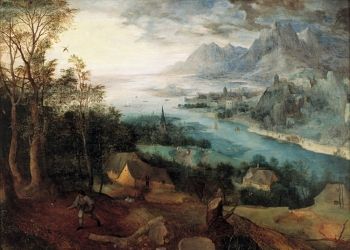
Pieter Bruegel the Elder's paintings of ordinary village life within a panoramic landscape were a primary influence upon Dutch Golden Age art, spurring the popularity of genre works, landscapes, and the overall Dutch emphasis on realistically depicting everyday existence. Breugel's work often employed the "world landscape," a construct that combined spectacular elements of European landscape, viewed from an elevated viewpoint, as seen in his Parable of the Sower (1557). The "idealized composite of the world taken in at a single Olympian glance," as described by art historian Simon Schama, was often employed within a Biblical or historical context.
The Master of The Small Landscapes
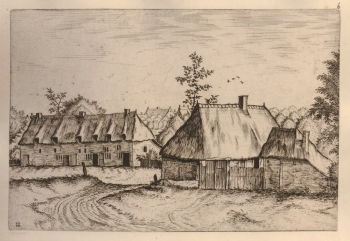
The anonymous artist, dubbed "the Master of the Small Landscapes" after his two volumes of The Small Landscapes were published in 1559 and 1561 in Antwerp, had a noted influence on Dutch Golden Age artists with his close-up views of recognizable Dutch locations. The emphasis upon the unique characteristics of Dutch landscape features, villages, and rural life connected with a rising sense of pride in Dutch identity and values. While painters in the Dutch Golden Age were to employ both the panoramic and close-up views, even artists who used the panoramic approach did so to depict actual locations with accurate detail.
Northern European Renaissance
The prints of Albrecht Dürer had a notable impact upon the flowering of printmaking in the Dutch Golden Age. Rembrandt van Rijn drew upon his techniques and motifs and even reinterpreted Dürer's Life of the Virgin (1503-1505) in his Simeon with the Christ Child in the Temple (c. 1639). The practice of including everyday scenes as well as still life in the works of Robert Campin and Jan van Eyck influenced both the development of genre work and still life painting. Dutch artists were known to take an element like the lily in a vase in Campin's Annunciation Triptych (c. 1425) and make it into the sole subject of the painting.
Utrecht Caravaggism
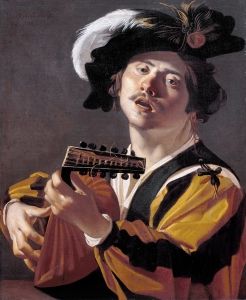
A number of Dutch painters from Utrecht, including Hendrick ter Brugghen, Dirck van Baburen, Matthias Stomer, and Gerrit van Horthorst spent the early 1600s in Rome where they were influenced by Caravaggio's tenebrism technique of manipulating light and dark within a painting to create the illusion of spotlights, as well as his subject matter. Returning to Utrecht, they reinterpreted Caravaggio's genre scenes of musicians, gypsies, or card-players, as seen in Dirck van Baburne's The Lute Player (1622), which influenced Frans Hals and Judith Leyster, among others.
Frans Hals
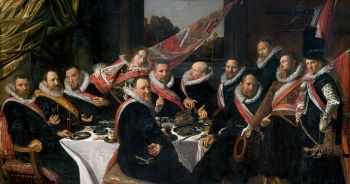
Frans Hals was an early pioneer of Dutch Golden Age painting, both in his portraiture and his genre work. He became famous with his group portrait The Banquet of the Officers of the St. George Militia Company (1616), and was much sought after as a portraitist in the decades following for his realistic individualized treatments. He emphasized a character-capturing moment and the employment of natural light depicted with a visible brushstroke to convey vitality. His work in genre was equally pioneering, as shown in his Yonker Ramp and His Sweetheart (1623), depicting a cavalier and his sweetheart in a moment of merriment. He influenced many subsequent Golden Age painters including Adriaen van Ostade, Adriaen Brouwer, and Judith Leyster.
Jan Bruegel the Younger
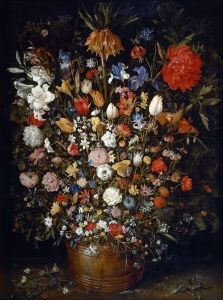
The Dutch Golden Age pioneered stilleven, or still life. This dominant element of Dutch art developed into a number of subtypes of which floral still life was the most popular. Jan Bruegel the Elder, son of Pieter Bruegel, was an early pioneer of the floral still life, in works like his Flowers in a Wooden Vessel (1606-1607). In it, he depicted an extravagant bouquet in a simple setting, combining rare and common flowers, and displaying the blooms without overlapping to show each flower rendered with scientific accuracy. He often traveled in order to observe and paint rare flowers, his enthusiasm for the subject leading to his being dubbed the "Flower Bruegel." Floral still life was incredibly popular among the Dutch, and their enthusiasm for collecting global botanical specimens was replicated in the commercial markets as seen by the 'tulip craze,' an extravagant period of bidding and speculation upon rare tulip bulbs that sold for exorbitant sums.
The Dutch Golden Age
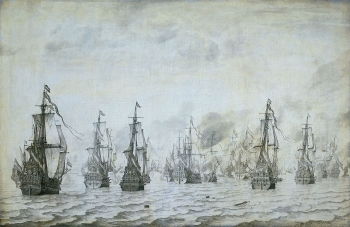
In 1568 the movement toward Dutch independence began with the religious rebellion of the Protestant Seven Provinces (modern day Netherlands) against the Catholic rule of Hapsburg Spain, which launched the Eighty Years' War. Independence from Spain was formally declared in 1581, though Dutch independence was not recognized by the Spanish government until 1648 at the end of the war. Religion played a leading role in the conflict, and both the Dutch Reformed church and a rising sense of Dutch nationalism informed the Golden Age. Art too took on independent directions, developing an emphasis on secular subjects, depicted not with Catholic grandeur, but emphasizing ordinary human life and realistic treatments.
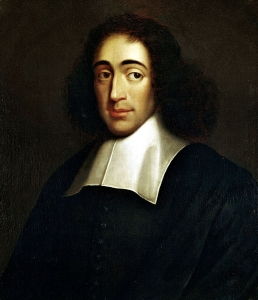
Antwerp, a major economic hub, like other cities in modern age Belgium had joined in the rebellion against Spain but was conquered by Spanish forces in 1585. The terms of the city's surrender included the provision that any Protestants had to leave the city within two years. As a result, many craftsmen and wealthy merchants went north to Amsterdam, creating an influx of businesses and skilled labor. The Dutch Republic also became home to other refugees, including the Protestant Huguenots from France, Sephardic Jews from Spain and Portugal, and the Pilgrims from Great Britain, and a thriving and tolerant cultural life developed. The Dutch Reformed church emphasized education as part of the individual's study of the Bible, and the University of Leiden became a hub for philosophy, scientific exploration and discovery. Dutch thinkers and scientists led in many fields, including the noted philosopher Baruch Spinoza, the physicist Christiaan Huygens, and the hydraulic engineer Jan Adriaanszoon Leeghwate. Other famous intellectuals whose ideas had come under religious scrutiny at home, including the French philosopher René Descartes and the English John Locke, were to find refuge in the intellectual tolerance of the Republic.
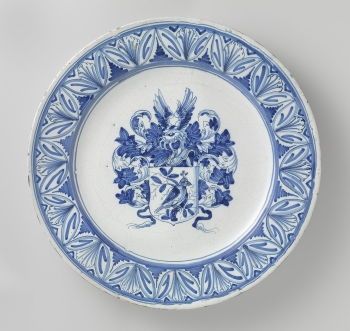
World trade was the engine that drove Dutch prosperity, as the Dutch East India Company, the first multinational corporation with shares that established the first stock exchange, was created in 1602. The Dutch traded both in Europe where they bought stockpiles of grain and in Asia where they had a trade monopoly. Spices, Chinese porcelain, Japanese vessels, and rare botanical specimens became part of a prosperous lifestyle. Their wealth also had more tragic sources, derived from colonization in the Americas, and a monopoly upon the slave trade to the Americas.
Patronage
The middle class and merchant class became the primary consumers of art, as the British writer Peter Munday wrote in 1640, "As for the art of Painting and the affection of the people to Pictures, I think none other go beyond them." Most works were small scale to decorate homes. Some scholars estimate that millions of art works were created in the era, as art also became a way of making a statement. Many people hung their best artworks in the large front rooms of their houses where they met the public or conducted business. While in the early 1600s there was a demand for Biblical scenes, by the mid-1600s the market was dominated by portraits, landscapes, still lifes, and genre works.
Dutch Golden Age Painting: Concepts, Styles, and Trends
Still Life
A number of noted subtypes were developed under the umbrella of Dutch still life painting, which includes vanitas, floral still life, ontbijtjes ("breakfast pieces")," and Pronkstilleven (an ostentatious display of food and expensive tableware).
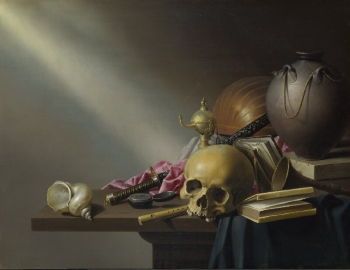
Vanitas paintings were still lifes that combined finely crafted items with Christian symbolism to convey a moral message of the transience of earthly life. Vanitas, meaning "vanity," drew upon the Biblical admonition in Ecclesiastes that "all is vanity," and the paintings were a primarily Protestant genre. Leiden, a Dutch city, known for its university that played an important theological role, became an early artistic center for vanitas painting, as seen in Harmen Steenwyck 's Still Life: An Allegory of the Vanities of Human Life (c. 1640). The motif became popular throughout the Netherlands, though each city had preferred objects for inclusion, as Amsterdam favored flowers, and The Hague, known as a marketplace, favored the inclusion of food, particularly fish.
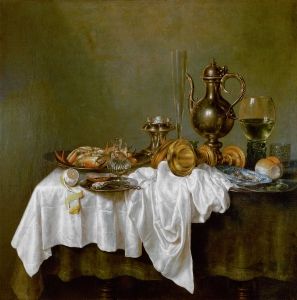
Scenes depicting lavish tables were very popular with Dutch patrons, and a number of subgenres developed, showing dinner pieces, late breakfast pieces, and the market scene. Breakfast pieces are some of the most noted artistically, due to their emphasis on composition and the treatment of light. A noted leader of the genre was Willem Claesz Heda, as seen in his Still life with oysters, a rummer, a lemon and a silver bowl (1634). Pieter Claesz was another leading proponent of the style, though his work often emphasized a vanitas theme.
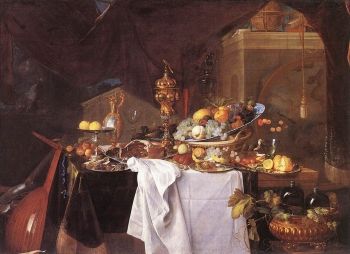
Pronkstilleven, meaning ostentatious still life, began in Antwerp and was quickly taken up by the Dutch Republic. Rare or desired objects obtained by trade were often included, amongst a plethora of objects including expensive dishware, rare and common fruits and flowers, food delicacies, and game, all symbolizing a rich lifestyle. Jan Davidsz de Heem was a leader of the style in Amsterdam as seen in his A Table of Desserts (1640). Willem Kalf also played a role in developing the genre, though his work emphasized small groupings of rare objects, as seen in Pronk Still Life with Holbein Bowl, Nautilus Cup, Glass Goblet and Fruit Dish (1678).
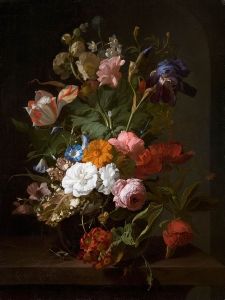
The artists most noted for floral still life included the females Maria van Oosterwijck, Rachel Ruysch, and Maria Sibylla Meria. Rachel Ruysch was internationally renowned for her floral still lifes that employed asymmetrical compositions and the effects of light to create a sense of energetic movement. She was also very successful, her works bringing higher prices than Rembrandt van Rijn's. Maria van Oosterwijck's floral pieces often evoked allegorical and religious meaning, as in her Vanitas-Still Life (1668), which powerfully combined the two subtypes. Maria Sibylla Meria emphasized a scientific approach to her depictions of botanical and zoological specimens, and is now renowned as an early founder of entomology, being the first to record the actual life cycle of the butterfly and other species.
Landscape Painting
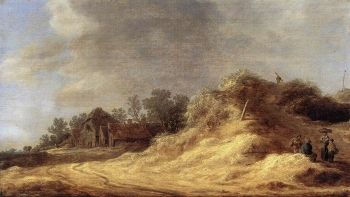
Landscape in the early 1600s was dominated by "the tonal style," pioneered by Esaias van de Velde. The style, as seen in his View of Zierikzee (1618), emphasized the sky and depicted the landscape with blurred outlines, all bathed in a unifying color and atmosphere. The style was widely adopted, and in particular by his student Jan van Goyen who would go on to create works in the vein such as Dune Landscape (1629).
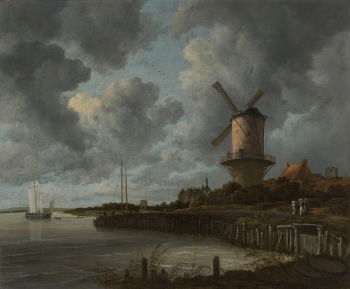
In the mid 1600's Dutch landscape took on what was called a "classical style," informed and exemplified by the works of Jacob van Ruisdael. While retaining an atmospheric effect, his works emphasized composition, often focused on a "heroic" windmill, tree, or tower, and strong contrasts of dark and light, as seen in his Windmill at Wijk bij Duurstede. At the same time he employed scientific observation. Van Ruisdael's work was both prolific and varied, as he painted not only Dutch landscapes and seascapes but Nordic forest scenes and mountains. He was also a noted teacher, as his student Meindert Hobbema became a renowned landscape artist.
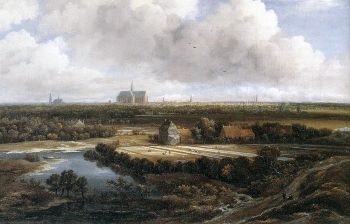
Landscapes were so popular that many subgenres developed, including general subgenres like the moonlight scene, the village scene, the farm scene, and woodland scenes as well as site-specific genres such as Haerlempjes, landscapes that included a view of Haarlem, which had previously been spelled Haerlem. Jacob von Ruisdael's Haarlem with the Bleaching Fields (c. 1670-1675) was a noted example of the genre.
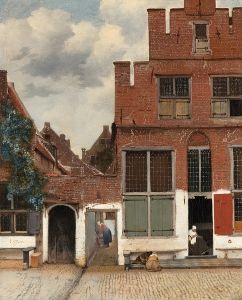
The most important subtypes, as they influenced later art movements and artists, were cityscapes, landscapes with animals in the foreground, and Italianate landscapes. Dutch cityscapes often emphasized views of urban life, as shown in Pieter de Hooch's The Courtyard of a House in Delft (1658). Johannes Vermeer's few cityscapes included both a more panoramic view of the skyline, as seen in his The View of Delft (c.1660-61), and his view of a city street, in The Little Street (c. 1658).
Jan Both was the leader in Italianate landscapes who was influenced by Claude Lorrain with whom he studied in Rome. Both painters produced views of idealized Italian landscapes, often containing classical ruins bathed in golden light. The style, exemplified in Both's Italian Landscape with a view of a harbor (1640-1652) was particularly favored by patrician patrons, and engravings reproducing Italianate landscapes were among the most popular of the day.
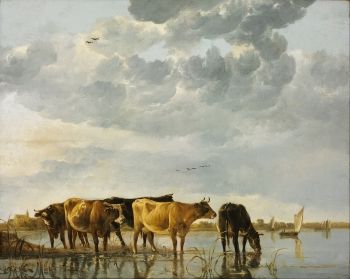
A number of artists specialized in painting landscapes with domestic animals, usually cows and horses, prominently featured in the foreground. Aelbert Cuyp was a noted master of the genre, as seen in his Cows in a River (c. 1650). Landscapes for Dutch patrons were often connected to a sense of national pride, and included elements symbolizing various Dutch values. For instance, the cow was seen as symbolizing the prosperity and the virtues of Dutch rural life. Similarly, Rembrandt's dramatic focus on a windmill in The Mill (1645-1648) evoked an identifying symbol of the Netherlands.
Printmaking
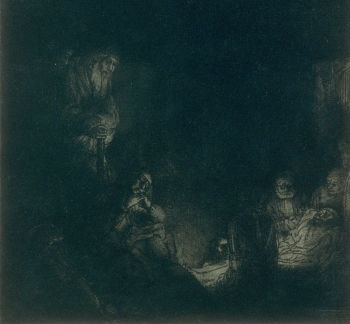
Drawing upon the Northern European tradition of printmaking, the noted printmakers of the Dutch Golden Age were Hercules Segers, Jacob van Ruisdael, and, towering above almost all printmakers of the era, Rembrandt. As renowned for his etchings as for his masterful paintings, Rembrandt was both innovative and prolific. He treated the plate like a canvas, leaving ink on the plate to vary different impressions of the same etching. He also innovatively reworked plates by scraping away etched areas and then redrawing with drypoint. His subjects were as widely varied as his paintings, including Biblical scenes, landscapes, portraits like Jan Lutma (1656), genre scenes like Goldsmith (1655), and nudes including his Reclining Female Nude (1658).
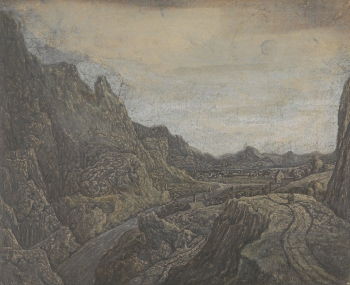
Innovative in both his imaginary landscapes and his pioneering printing techniques, Hercules Segers has been described by contemporary art historian Nadine Orenstein, as "one of the most fertile artistic minds of his era." He pioneered a three-tone etching process and an early method of intaglio color printing to create what were called "printed paintings." Using different colors of paper, which he painted before printing, then subsequently painting the print itself with watercolor, he created luminous landscapes keyed to the atmosphere and light of the time of day. Rembrandt admired and collected a number of his prints, as seen in his repurposing Seger's print Tobias and the Angel (c. 1633) into his own The Flight into Egypt (1653).
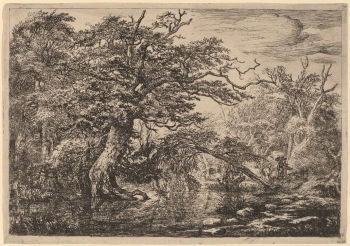
Jan van Ruisdael's landscape etchings were also much admired and had a long lasting influence on later landscape painting. The precise observation of his meticulously rendered locations combined with their luminous effect, as seen in his Forest Marsh with Travellers on a Bank (1640s-1650s) were to have a noted influence on later artists like John Constable and those of the Barbizon School.
Historical Painting
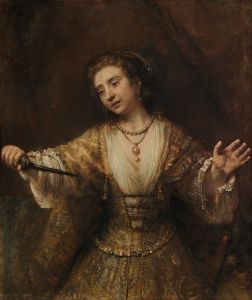
While the academy considered historical painting, a category that also included Biblical, mythological, and allegorical subjects, the highest form of painting, the taste and sensibility of the Dutch Golden Age preferred works that depicted ordinary subjects. Nonetheless, masterworks of historical painting were created in the era, most notably by Rembrandt. Originally focusing on history painting, he found success as a portraitist, though his interest in history painting never faded, as seen in his Aristotle Contemplating the Bust of Homer (1653) and his Lucretia (1664). The category also allowed for painting the nude, and his works like Bathsheba Holding King David's Letter (1654) are the few nude masterpieces of the era.
Genre Painting
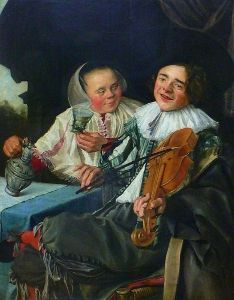
The Dutch Golden Age developed the art of genre paintings. This included works depicting musicians, tavern scenes, housewives in quiet interiors, courtship scenes, festive occasions, and brothel scenes, to name just a few. Pieter Bruegel's scenes of village life, often pointing out human folly, influenced the development of what were called kleyne beuzelingen, or little trifles. Frans Hals led this evolution of genre painting, as seen in his Merrymakers at Shrovetide (c. 1616-17). Judith Leyster, one of only two women to be admitted to the 17th century painters' guild, was also a noted genre painter, specializing in musicians, children at play, and merrymaking couples. Often, genre painting took on a moralizing theme, whether portraying moral turpitude with comic effect, as seen in Jan Steen's The Dissolute Household (c. 1663-1664), or emphasizing virtue, as seen in Pieter de Hooch's Interior with a Young Couple (c. 1662-1665).
Later Developments - After Dutch Golden Age Painting
The Dutch Golden Age began to decline with the start of the Franco-Dutch War, when the French invaded the Netherlands in 1672. To expel the invaders the Dutch broke the dykes, flooding much of the land, and, as a result, the Dutch still refer to 1672 as "The Disaster Year." As the economy crashed, so did the art market, impacting artists including Vermeer who went bankrupt. By the time the war ended in 1678, Dutch power had been severely diminished and the art market never recovered.
Nonetheless, Dutch genre works influenced French painters, including Jean Siméon Chardin, Jean Baptiste Greuze, and Jean Honoré Fragonard, as Rococo style, led by the French, became dominant in the early 1700s. However, in general the works of many Dutch masters, including Rembrandt, Hals, and Vermeer fell out of favor in the late 17th through 18th centuries. As classical refinement was favored, Hals' brushwork was critiqued as slapdash, and critics took umbrage at the gritty humanism of Rembrandt.
Rembrandt was rediscovered during the Romantic movement in the early 1800s, as the critic William Hazlitt described him as "a man of genius" who "took any object, he cared not what, how mean soever in form, color and expression, and from the light and shade which he threw upon it, it came out gorgeous from his hands." As a result, Rembrandt informed Eugene Delacroix and J.M.W. Turner, by what Turner called his "veil of matchless color." His influence on artists continued throughout the 19th century, affecting Vincent van Gogh, Auguste Rodin, and the American Thomas Eakins, and into the 20th century where he had an impact on the work of Pablo Picasso, Frank Auerbach, and Francis Bacon, and countless others.
Jacob van Ruisdael was rediscovered in the late 1700s by John Constable who owned four of the artist's etchings and copied a number of the artist's works. Subsequently, Van Ruisdael's landscapes were a primary influence upon the Barbizon School and the Hudson River School.
In 1842 the art critic Théophile Thoré-Bürger rediscovered Vermeer whom he dubbed "the Sphinx of Delft," along with other Dutch Golden Age painters including Hals and Carel Fabritius. As a result a number of artists including Gustave Courbet, James Abbott McNeill Whistler, Édouard Manet, Edgar Degas, Camille Pissarro, and Claude Monet were influenced by the artist's realistic depiction of ordinary life, and his painting of the effects of light. Hals' rough style had a noted influence on later artists of the Realist movement, including Gustave Courbet and Manet, as well as the Impressionists Monet and Mary Cassatt.
Additionally Dutch still lifes had a noted impact on Western art, as the subject remained popular into the modern era, as seen in the works of Vincent van Gogh, Paul Cezanne, Emil Nolde, Giorgio Morandi, and Henri Matisse's Variation on a Still Life by de Heem (1915). Dutch landscape painting influenced the development of the Barbizon School, the Hudson River School, Tonalism, and Luminism.
Useful Resources on Dutch Golden Age Painting
-
![Art from the Dutch Golden Age]() 31k viewsArt from the Dutch Golden AgeOur PickBy ArtGallery of NSW
31k viewsArt from the Dutch Golden AgeOur PickBy ArtGallery of NSW -
![Edwin Buijsen: "Behind the Scenes of Everyday Life: Dutch Genre Painting"]() 870 viewsEdwin Buijsen: "Behind the Scenes of Everyday Life: Dutch Genre Painting"Our Pick
870 viewsEdwin Buijsen: "Behind the Scenes of Everyday Life: Dutch Genre Painting"Our Pick -
![Rineke Dijkstra & Hans den Hartog Jager: "The Dutch Tradition of Portraiture"]() 713 viewsRineke Dijkstra & Hans den Hartog Jager: "The Dutch Tradition of Portraiture"
713 viewsRineke Dijkstra & Hans den Hartog Jager: "The Dutch Tradition of Portraiture"
-
![The Power of Art: Rembrandt]() 131k viewsThe Power of Art: RembrandtOur PickBBC / May only work in the US.
131k viewsThe Power of Art: RembrandtOur PickBBC / May only work in the US. -
![Curator's Perspective: Rembrandt and the Dutch Golden Age]() 2k viewsCurator's Perspective: Rembrandt and the Dutch Golden AgeBy Salvador Salort-Pons / Frist Art Museum
2k viewsCurator's Perspective: Rembrandt and the Dutch Golden AgeBy Salvador Salort-Pons / Frist Art Museum -
![Vermeer: Master of Light]() 989k viewsVermeer: Master of LightOur PickNational Gallery of Art
989k viewsVermeer: Master of LightOur PickNational Gallery of Art -
![Vermeer - Secret Lives of the Artists]() 175k viewsVermeer - Secret Lives of the ArtistsBBC
175k viewsVermeer - Secret Lives of the ArtistsBBC -
![Arthur Wheelock: "The Making of an Icon: Girl with a Pearl Earring"]() 1k viewsArthur Wheelock: "The Making of an Icon: Girl with a Pearl Earring"
1k viewsArthur Wheelock: "The Making of an Icon: Girl with a Pearl Earring" -
![Judith Leyster: Self-Portrait]() 2k viewsJudith Leyster: Self-PortraitOur PickNational Gallery of Art
2k viewsJudith Leyster: Self-PortraitOur PickNational Gallery of Art -
![How a Dutch Master Made 'The Goldfinch' Come Alive]() 13k viewsHow a Dutch Master Made 'The Goldfinch' Come AliveTalk by Edwin Buijsen / The Frick
13k viewsHow a Dutch Master Made 'The Goldfinch' Come AliveTalk by Edwin Buijsen / The Frick - Simon Schama: Rembrandt, Masterpieces of the Late Years
-
![Opening Day Lecture: Girl with a Pearl Earring: Dutch Paintings from the Mauritshuis]() 19k viewsOpening Day Lecture: Girl with a Pearl Earring: Dutch Paintings from the MauritshuisOur PickBy Melissa Buron / Fine Arts Museums of San Francisco
19k viewsOpening Day Lecture: Girl with a Pearl Earring: Dutch Paintings from the MauritshuisOur PickBy Melissa Buron / Fine Arts Museums of San Francisco -
![Introduction to the Exhibition: Vermeer and the Masters of Genre Painting: Inspiration and Rivalry]() 11k viewsIntroduction to the Exhibition: Vermeer and the Masters of Genre Painting: Inspiration and RivalryTalk James Heard / National Gallery of Art
11k viewsIntroduction to the Exhibition: Vermeer and the Masters of Genre Painting: Inspiration and RivalryTalk James Heard / National Gallery of Art -
![Rembrandt: The Power of his Self-Portraits]() 403k viewsRembrandt: The Power of his Self-PortraitsOur PickTalk James Heard / National Gallery of Art
403k viewsRembrandt: The Power of his Self-PortraitsOur PickTalk James Heard / National Gallery of Art -
![Lecture 6: Johannes Vermeer's View of Delft: The Prose and Poetry of View Painting]() 33k viewsLecture 6: Johannes Vermeer's View of Delft: The Prose and Poetry of View PaintingYale University Art Gallery
33k viewsLecture 6: Johannes Vermeer's View of Delft: The Prose and Poetry of View PaintingYale University Art Gallery -
![Jacob van Ruisdael's Windmill at Wijk bij Duurstede and Dutch Landscape]() 20k viewsJacob van Ruisdael's Windmill at Wijk bij Duurstede and Dutch LandscapeOur PickYale University Art Gallery
20k viewsJacob van Ruisdael's Windmill at Wijk bij Duurstede and Dutch LandscapeOur PickYale University Art Gallery -
![Frans Hals in the Metropolitan Museum]() 33k viewsFrans Hals in the Metropolitan MuseumTalk by Walter Liedtke
33k viewsFrans Hals in the Metropolitan MuseumTalk by Walter Liedtke -
![Frans Hals - Master Series Lecture]() 4k viewsFrans Hals - Master Series LectureTalk by Pieter Biesboer / Toledo Museum of Art
4k viewsFrans Hals - Master Series LectureTalk by Pieter Biesboer / Toledo Museum of Art
 Ask The Art Story AI
Ask The Art Story AI